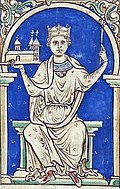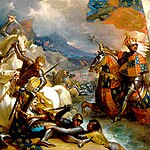Wikipedia:Today's featured article/August 2019
| << | Today's featured articles for August 2019 | >> | ||||
|---|---|---|---|---|---|---|
| Su | Mo | Tu | We | Th | Fr | Sa |
| 1 | 2 | 3 | ||||
| 4 | 5 | 6 | 7 | 8 | 9 | 10 |
| 11 | 12 | 13 | 14 | 15 | 16 | 17 |
| 18 | 19 | 20 | 21 | 22 | 23 | 24 |
| 25 | 26 | 27 | 28 | 29 | 30 | 31 |
August 1
"Touch Me I'm Sick" is a song by the American alternative rock band Mudhoney. It was recorded in March 1988 at Seattle's Reciprocal Recording studio with producer Jack Endino and lead vocals by Mark Arm (pictured). The song was released as Mudhoney's debut single by independent record label Sub Pop on August 1, 1988, with "Sweet Young Thing Ain't Sweet No More" as the B-side. "Touch Me I'm Sick" has darkly humorous lyrics with a sarcastic take on issues including disease and violent sex. When it was first released, the song was a hit on college radio. Its heavily distorted and fuzzy guitars, snarling vocals, blunt bass line and energetic drumming contributed to a dirty sound that influenced many local musicians, and helped develop the nascent Seattle grunge scene. According to AllMusic, "the song's raw, primal energy made it an instant anthem which still stands as one of [grunge's] all-time classics". A staple of Mudhoney's live shows, it remains the band's most recognizable song. (Full article...)
August 2
Ryūjō ("Prancing Dragon") was a light aircraft carrier built for the Imperial Japanese Navy during the early 1930s. Small and lightly built in an attempt to exploit a loophole in the Washington Naval Treaty of 1922, she proved to be top-heavy and only marginally stable, and was back in the shipyard for modifications within a year of completion. With her stability improved, Ryūjō returned to service and was employed in operations during the Second Sino-Japanese War. During World War II, she provided air support for operations in the Philippines, Malaya, and the Dutch East Indies, where her aircraft participated in the Second Battle of the Java Sea. During the Indian Ocean raid in April 1942, the carrier attacked British merchant shipping with both her guns and her aircraft. Ryūjō participated in the Battle of the Aleutian Islands in June. She was sunk by American carrier aircraft at the Battle of the Eastern Solomons on 24 August 1942. (Full article...)
August 3
"The Truth" was the two-hour ninth-season finale of the American science fiction television series The X-Files, premiering on May 19, 2002. Written by series creator Chris Carter and directed by Kim Manners, the finale was the most-watched episode of the ninth season, with 13.25 million viewers. It received mixed reviews, with many commentators criticizing its lack of closure. Others were pleased with the episode's conclusion and with the full return of actor David Duchovny (pictured) as Fox Mulder, following his departure from the series after the eighth-season finale. The ninth season focused on the paranormal investigations of FBI special agents John Doggett (Robert Patrick), Monica Reyes (Annabeth Gish), and Dana Scully (Gillian Anderson). In the finale, Scully learns that Mulder—who had been missing for almost a year—was being held for the supposed murder of a bioenhanced soldier in a secret government program. "The Truth" served to conclude many story arcs. (Full article...)
August 4
Ms Dhu was a 22-year-old Australian Aboriginal woman who died in police custody in Western Australia on 4 August 2014. Dhu had been arrested two days earlier for unpaid fines, and was required to serve four days in custody to clear part of the debt. While detained, Dhu complained of pain and was taken to hospital. Police accused her of faking her condition, and medical staff believed her complaints were exaggerated and suspected drug withdrawal. Dhu died shortly after arriving on her third visit to hospital. The cause of death was an infection due to three-month-old rib fractures caused by her partner. An internal police investigation found 11 officers had not complied with regulations or were guilty of misconduct. A coronial inquest found that she suffered "unprofessional and inhumane" handling by police and "deficient" treatment from hospital staff. The inquest recommended not imprisoning people for unpaid fines and introducing a Custody Notification Scheme. (Full article...)
August 5
Stephen, King of England (c. 1094 – 1154), ruled from 1135 until his death. Born in the County of Blois in central France, he was brought up by his mother, Adela, daughter of William the Conqueror. Placed into the court of his uncle, Henry I of England, Stephen rose in prominence and was granted extensive lands. When Henry died in 1135, Stephen crossed the English Channel and took the throne in spite of his earlier oaths to support the claim of Henry's daughter, the Empress Matilda. In 1138 the Empress's half-brother Robert of Gloucester rebelled against Stephen, and in 1139 the Empress and Robert invaded England. The revolt took hold in the south-west, and Stephen was captured at the battle of Lincoln in 1141. He was abandoned by many of his followers and lost control of Normandy. He was freed after Robert was captured at the Rout of Winchester, but the civil war dragged on for many years. Upon his death, he was succeeded by the Empress's son, Henry II, the first of the Angevin kings. (Full article...)
August 6
Analog Science Fiction and Fact is an American science fiction magazine, first published in 1930 as Astounding Stories of Super-Science. After F. Orlin Tremaine was hired as editor in 1933, it became the leading magazine in the nascent pulp science fiction field, with well-regarded stories such as Jack Williamson's Legion of Space and "Twilight" by John W. Campbell. Campbell took over editorial duties from 1937 to 1971, running many stories that became classics in the field, including Isaac Asimov's Foundation series, A. E. van Vogt's Slan, and novels and stories by Robert A. Heinlein. By 1950, Astounding was no longer regarded as the leader in the field, though it did continue to publish popular and influential stories, including Hal Clement's novel Mission of Gravity (1953) and Tom Godwin's "The Cold Equations" (1954). Ben Bova took over as editor from 1972 to 1978, winning five consecutive Hugo Awards. Trevor Quachri currently edits the magazine for Crosstown Publications. (Full article...)
August 7
The Siberian accentor (Prunella montanella) is a small passerine bird that breeds in northern Russia from the Ural Mountains eastwards across Siberia. It is migratory, wintering in Korea and eastern China. Typically breeding in subarctic deciduous forests and open coniferous woodland, often near water, it is also found in bushes and shrubs in winter, frequently near streams. It has brown upperparts and wings, with bright chestnut streaking on its back and a greyish-brown rump and tail. The head has a dark brown crown and a long pale yellow "eyebrow". All plumages are similar. The nest is an open cup into which the female lays four to six eggs that hatch in about ten days. Adults and chicks feed mainly on insects, typically picked off the ground, and may also eat seeds in winter. Breeding over a huge area, this accentor has a large and apparently stable population. October and November 2016 saw an unprecedented influx of this species into western Europe as far west as the UK. (Full article...)
August 8
Portrait Diptych of Dürer's Parents is the collective name for two late-15th-century portrait panels by the German painter Albrecht Dürer. They show his parents, Barbara Holper and Albrecht Dürer the Elder, when she was around 39 and he was 63, and are among four paintings or drawings Dürer made of the couple. The portraits are unflinching records of the physical and emotional effects of ageing, which Dürer may have intended either to display his skill to his parents or as keepsakes while he travelled as a journeyman painter. His father's panel is considered the superior work and has been described as one of Dürer's most exact and honest portraits. The Dürer family was close, and his later writings show the love and respect he felt toward his parents. The panels, separated since at least 1628, were reunited in the Germanisches Nationalmuseum's 2012 exhibition "The Early Dürer". (Full article...)
August 9
The Gadsden Purchase half dollar was a proposed commemorative coin to be issued by the United States Bureau of the Mint. El Paso coin dealer L. W. Hoffecker (pictured) wanted a coin issued he could control and distribute. He gained the support of several members of Congress, and a bill was introduced. Treasury Secretary Andrew W. Mellon sent a letter and two officials in opposition to the bill at its committee hearing, but it passed both houses of Congress without dissent. On April 21, 1930, President Herbert Hoover vetoed the bill, deeming commemorative coins abusive; the House of Representatives sustained his veto. No commemorative coins were struck during the remainder of the Hoover administration, and although they began again after Franklin D. Roosevelt was inaugurated, in 1938, Roosevelt vetoed one, citing Hoover's action, as would Truman and Eisenhower. No commemorative coins were struck from 1955 until after the Treasury Department changed its position in 1981. (Full article...)
August 10
Keswick is an English market town and civil parish, historically in Cumberland, and since 1974 in the Borough of Allerdale in Cumbria. The town, in the Lake District National Park, just north of Derwentwater, and 4 miles (6.4 km) from Bassenthwaite, had a population of 4,821 at the time of the 2011 census. There is considerable evidence of prehistoric occupation of the Keswick area. The first recorded mention of the town dates from the 13th century, when Edward I granted a charter for Keswick's market, which has maintained a continuous 700-year existence. In Tudor times the town was an important mining area, and from the 18th century onwards it has increasingly been known as a holiday centre; tourism has been its principal industry for more than 150 years. Two of the Lake Poets, Samuel Taylor Coleridge and Robert Southey, lived in Keswick in the early 19th century and made the scenic beauty of the area widely known to readers in Britain and beyond. (Full article...)
August 11
The European hare (Lepus europaeus) is one of the largest hare species. Native to Europe and parts of Asia, it is adapted to temperate, open country. Hares feed mainly on grasses and herbs, supplementing these with twigs, buds, bark and field crops, particularly in winter. They rely on high-speed endurance running to escape predators, including large birds of prey, canids and felids. Generally nocturnal and shy, hares can be seen in the spring in broad daylight chasing one another around in fields, and sometimes striking each other with their paws ("boxing"). The female nests in a depression on the surface of the ground, giving birth to three or four kits that are active as soon as they are born. The European hare has a wide range and is moderately abundant, but populations have been declining in mainland Europe since the 1960s. The hare has been a traditional symbol of fertility and reproduction in some cultures. (Full article...)
August 12
Hurricane Nadine was the fourth-longest-lived Atlantic hurricane on record. The fourteenth tropical cyclone and named storm of the 2012 Atlantic hurricane season, it developed from a tropical wave west of Cape Verde on September 10. By the following day, it had strengthened into a tropical storm. Well away from any landmass, Nadine reached hurricane status on September 15. Two days later, the storm began moving northeastward toward the Azores, producing tropical-storm-force winds on a few islands, but on September 19 it veered east-southeastward before reaching them. On September 21 Nadine transitioned into a non-tropical low pressure area. Its remnants regenerated into a tropical cyclone on September 24 and became a hurricane again on September 28. After transitioning into an extratropical cyclone, the remnants of Nadine passed through the Azores on October 4 and again brought strong winds to the islands. (Full article...)
August 13
Henry Burrell (13 August 1904 – 9 February 1988) was a senior commander in the Royal Australian Navy. During the 1920s and 1930s, he served for several years on exchange with the Royal Navy, specialising as a navigator. Following the outbreak of World War II, he filled a key liaison post with the US Navy, and later saw action as commander of the destroyer HMAS Norman, earning a mention in despatches. Promoted captain in 1946, Burrell commanded the flagship HMAS Australia in 1948–49. He captained the light aircraft carrier HMAS Vengeance in 1953–54, and was twice Flag Officer of the Australian Fleet. As Chief of the Naval Staff from 1959 to 1962, he began a major program of acquisitions for the Navy, including new helicopters, minesweepers, submarines and guided-missile destroyers. In 1959 Burrell was appointed a Companion of the Order of the Bath and was raised to vice admiral. He was knighted in 1960 and retired two years later. (Full article...)
August 14
The Sega Genesis, or Mega Drive, is a 16-bit home video game console developed and sold by Sega. It was Sega's third console and the successor to the Master System. Released in Japan in 1988, in North America in 1989, and worldwide in 1990, it was adapted from Sega's System 16 arcade system board, with a Motorola 68000 processor and a Zilog Z80 sound controller chip. In Japan, the Mega Drive fared poorly against its two main competitors, Nintendo's Super Nintendo Entertainment System and NEC's PC Engine. The Genesis achieved considerable success in North America, Brazil, and Europe, thanks to its library of arcade game ports, the popularity of Sega's Sonic the Hedgehog series, several popular sports franchises, and aggressive youth marketing. It was succeeded in 1994 by the Sega Saturn. More than 30 million first-party Genesis units were sold worldwide. (Full article...)
Part of the Sega Genesis featured topic.
August 15
Bernard Fanning (born 15 August 1969) is an Australian musician and singer-songwriter. He is best known as the lead singer and frontman of Queensland alternative rock band Powderfinger. Born and raised in Toowong, Brisbane, he began writing music at 15. With Ian Haug, John Collins, and Darren Middleton, the band released five studio albums in fifteen years and achieved mainstream success in Australia. During Powderfinger's hiatus in 2005, Fanning began his solo music career with the studio album Tea & Sympathy. Powderfinger reunited in 2007 and released two more albums before disbanding in 2010. While Powderfinger's style focuses on alternative rock, Fanning's solo music is generally described as a mixture of blues and acoustic folk. He plays guitar, piano, keyboards and harmonica. Often speaking out against Australian political figures, Fanning has donated much of his time to philanthropic causes. (Full article...)
August 16
Kalidas is a lost 1931 Indian biographical film directed by H. M. Reddy and produced by Ardeshir Irani. No print, gramophone record, or songbook of the film is known to survive. It was the first sound film to be made in Tamil, with additional dialogue in Telugu and Hindi. Based on the life of the Sanskrit poet Kālidāsa, it featured P. G. Venkatesan in the title role and T. P. Rajalakshmi as the female lead, with L. V. Prasad, Thevaram Rajambal, T. Susheela Devi, J. Sushila, and M. S. Santhanalakshmi in supporting roles. It was shot in Mumbai on the sets of India's first sound film Alam Ara (1931) and was completed in eight days. Despite its mythological theme, the film featured songs from modern times, including the compositions of Carnatic musician Tyagaraja, publicity songs of the Indian National Congress, and songs about Mahatma Gandhi and the Indian independence movement. (Full article...)
August 17
Paraceratherium was a hornless rhinoceros, and one of the largest terrestrial mammals that has ever existed. The genus lived during most of the Oligocene epoch (34–23 million years ago); its remains have been found across Eurasia between China and the Balkans. Its weight is estimated to have been 15 to 20 tonnes (33,000 to 44,000 lb); the shoulder height was about 4.8 metres (15.7 feet), and the length about 7.4 metres (24.3 feet). The legs were long and pillar-like. The long neck supported a skull that was about 1.3 metres (4.3 ft) long. It had large, tusk-like incisors and a nasal incision that suggests it had a prehensile upper lip or trunk. The lifestyle of Paraceratherium may have been similar to that of large mammals such as elephants and modern rhinoceroses. It was a browser, eating mainly leaves, soft plants, and shrubs. It lived in habitats ranging from arid deserts with scattered trees to subtropical forests. (Full article...)
August 18
Trafford Park is an area of the Metropolitan Borough of Trafford, Greater Manchester, England, opposite Salford Quays on the southern side of the Manchester Ship Canal, 3.4 miles (5.5 km) southwest of Manchester city centre. Until the late 19th century, it was the ancestral home of the Trafford family, who sold it to financier Ernest Terah Hooley in 1896. It was the first planned industrial estate in the world and remains the largest in Europe, at 4.7 square miles (12 km2). Trafford Park was a major supplier of materiel in the First and Second World Wars, producing the Rolls-Royce Merlin engines used to power both the Spitfire and the Lancaster. At its peak in 1945, an estimated 75,000 workers were employed in the park. Employment began to decline in the 1960s as companies closed in favour of newer, more efficient plants elsewhere. The new Manchester Metrolink line from Pomona to the Trafford Centre is under construction. (Full article...)
August 19
The Australian women's national wheelchair basketball team played in the 2012 Summer Paralympics in London. The wheelchair basketball team, known as the Gliders, included nine Paralympic veterans, Bridie Kean, Amanda Carter, Sarah Stewart, Tina McKenzie, Kylie Gauci, Katie Hill, Cobi Crispin, Clare Nott and Shelley Chaplin (pictured), along with three newcomers, Amber Merritt, Sarah Vinci and Leanne Del Toso. The team had won silver in Sydney and Athens, but never gold. The Gliders faced a formidable task just to make the finals, as their round-robin pool included Brazil, Great Britain, Canada and the Netherlands. After a narrow victory over Brazil, and an easier one against Great Britain, the Gliders were defeated by Canada, but won their final match against the Netherlands to finish at the top of their pool. They went on to win the quarterfinal against Mexico and the semifinal against the United States, but lost to Germany in the final, winning silver. (Full article...)
August 20
The Marchioness disaster was a collision between two vessels on the River Thames in London in the early hours of 20 August 1989 that resulted in the deaths of 51 people. The pleasure steamer Marchioness, with about 130 people on board, sank after being hit twice by the dredger Bowbelle. The Marine Accident Investigation Branch blamed a lack of lookouts, but it was criticised by the families of the victims for failing to interview anyone on Marchioness or Bowbelle. A formal inquiry was finally held in 2000; its report concluded that "The basic cause of the collision is clear. It was poor lookout on both vessels. Neither vessel saw the other in time to take action to avoid the collision." Further criticism was aimed at the owners of both ships, at the Department for Transport and at the Port of London Authority. The collision and the subsequent reports led to increased safety measures on the Thames, and four new lifeboat stations were installed on the river. (Full article...)
August 21
Hillary Clinton (born 1947) is an American politician, diplomat, lawyer, and writer. She was First Lady of the United States from 1993 to 2001, a U.S. senator from New York from 2001 to 2009, and the 67th secretary of state from 2009 to 2013. As a Democrat running in the 2016 presidential election, she became the first woman to receive the nomination of a major U.S. political party. Clinton was raised in the Chicago suburb of Park Ridge. She graduated from Wellesley College, and in 1973 earned a law degree from Yale, where she met future president Bill Clinton; they married in 1975. She was appointed the first female chair of the Legal Services Corporation in 1978. As U.S. secretary of state in the Obama administration, Clinton helped organize international sanctions against Iran in an effort to curtail that country's nuclear program, leading to the multinational Joint Comprehensive Plan of Action agreement in 2015. (Full article...)
August 22
Operation Goodwood was a series of air raids launched from aircraft carriers of the British Home Fleet against the German battleship Tirpitz in Kaafjord, Norway. It was the Royal Navy's last attack on Tirpitz, which posed a significant threat to the Allied convoys travelling to the Soviet Union. The Fleet departed its base on 18 August 1944 and first launched air raids against Kaafjord on the morning and evening of 22 August. Further attacks were made on 24 and 29 August. All of these attacks failed, and only two bombs struck Tirpitz. German forces suffered the loss of 12 aircraft and damage to 7 other ships. The British lost 17 aircraft and a frigate. HMS Nabob, an escort carrier, was also badly damaged. Historians attribute Operation Goodwood's failure to shortcomings of the Fleet Air Arm's aircraft and armament. The mission to sink Tirpitz was subsequently transferred to the Royal Air Force. (Full article...)
August 23
Taylor Swift (born 1989) is an American singer-songwriter. She has sold more than 50 million albums and 150 million single downloads worldwide. Swift released her self-titled debut album in 2006, which spent more weeks than any other album on the Billboard 200 in the 2000s. Her second album, Fearless (2008), became the best-seller of 2009 in the US and won four Grammy Awards, with Swift becoming the youngest Album of the Year winner. With her later albums Speak Now (2010), Red (2012), 1989 (2014) and Reputation (2017), she became the first act to have four albums sell a million copies within one week in the US. The last three albums spawned the number-one singles "We Are Never Ever Getting Back Together", "Shake It Off", "Blank Space", "Bad Blood", and "Look What You Made Me Do". Swift's many accolades include ten Grammy Awards and appearances in Rolling Stone's 100 Greatest Songwriters of All Time, Time 100, and Forbes Celebrity 100. (Full article...)
August 24
The Battle of Blanchetaque was fought on 24 August 1346, during the early stages of the Hundred Years' War, between an English army under King Edward III and a French force commanded by Godemar du Fay. The English army had burnt a path of destruction through some of the richest lands in France to within 20 miles (32 km) of Paris, then had marched north, hoping to link up with an allied Flemish army. The French king, Philip VI, garrisoned all of the bridges and fords over the River Somme and followed the English with his own field army. The area had previously been stripped of food stocks, and the English were essentially trapped. They launched an attack across a tidal ford at Blanchetaque, and after a disorderly mêlée the French blocking force there broke and fled. French casualties were reported as over half of their force, while English losses were light. Two days later, the main army under Philip was defeated at the Battle of Crécy. (Full article...)
Part of the Crécy campaign featured topic.
August 25
Richie Farmer (born August 25, 1969) is a former collegiate basketball player and Republican Party politician from the U.S. state of Kentucky. He led Clay County High School to the 1987 state high school boys' basketball championship, scoring a championship game record 51 points and being named 1988's Kentucky Mr. Basketball. He played collegiately for the Kentucky Wildcats. In his senior year, the team reached the Elite Eight of the 1992 NCAA Tournament, losing to Duke in one of the most memorable college basketball games ever. He served as Kentucky Agriculture Commissioner from 2004 to 2012, winning two terms by large margins. Kentucky Senate President David L. Williams made Farmer his running mate in the 2011 gubernatorial election, but their ticket was defeated. After leaving office as commissioner, Farmer was investigated for corruption and was eventually sentenced to 27 months in federal prison. He was released from a halfway house in 2016. (Full article...)
August 26
The Alabama Centennial half dollar is a commemorative fifty-cent coin struck by the United States Bureau of the Mint in 1921 as a belated acknowledgement of the 100th anniversary of Alabama's admission to the Union in 1819. The half dollar was created by Laura Gardin Fraser, who became the first woman to design a coin. Alabama Congressman Lilius Bratton Rainey introduced authorizing at the request of the state's centennial commission. The bill moved quickly through the legislative process and became law on May 10, 1920. The sponsors of the issue chose to depict William Bibb, the State of Alabama's first governor, and Thomas Kilby, its governor at the time of the centennial, thus making Governor Kilby the first living person to appear on a U.S. coin. They were issued in October 1921. To boost sales, the mark "2X2" was included on a minority of the coins; these are generally more expensive today. (Full article...)
August 27
William Hayden English (August 27, 1822 – February 7, 1896) was a US Representative from Indiana and the Democratic nominee for vice president in 1880. English entered politics at a young age, becoming part of the conservative wing of the state Democratic Party. He was elected to the Indiana House of Representatives in 1851 and served as its speaker at the age of 29. Elected to Congress in 1852, he served four terms, leaving office in 1861. English was a War Democrat, supporting the Union in the Civil War. He was successful in business, and became one of the wealthiest people in Indiana. He returned to political life as Winfield Scott Hancock's running mate in 1880, but they were narrowly defeated by their Republican opponents, James A. Garfield and Chester A. Arthur. Afterwards, English continued in business and wrote two books. (Full article...)
Part of the 1880 United States presidential election featured topic.
August 28
Vesna Vulović (1950–2016) was a Serbian flight attendant who holds the Guinness world record for surviving the highest fall without a parachute: 10,160 metres (33,330 ft). She was the sole survivor after a briefcase bomb tore through the baggage compartment of JAT Flight 367 on 26 January 1972, causing it to crash over Czechoslovakia. She spent days in a coma with a fractured skull and many broken bones, and was temporarily paralyzed from the waist down. Vulović eventually relearned how to walk, but continued to limp for the rest of her life. She was widely regarded as a national hero in Yugoslavia. Guinness recognized her world record in 1985. She was fired from JAT in the early 1990s for taking part in anti-government protests, but continued her work as a pro-democracy activist for decades. The final years of her life were spent in seclusion and poverty, and she struggled with survivor's guilt until her death. (Full article...)
August 29
All Money Is Legal is the debut studio album by American rapper Amil (pictured). A hip hop album, it was released on August 29, 2000, through Roc-A-Fella, Columbia, and Sony Music. Jay-Z, Damon Dash, and Amil served as executive producers. Future spouses Jay-Z and Beyoncé met for the first time during the album's recording sessions. Although Jay-Z had written Amil's verses for their past collaborations, she wrote her own lyrics for all of the album's tracks. The songs focus on wealth and, to a lesser degree, Amil's personal life. Reviews were mixed; critics were divided over the album's production and Amil's verses. It peaked at number 45 on the US Billboard 200 chart. Two singles – "I Got That" with vocals from Beyoncé and "4 da Fam" with verses from Memphis Bleek, Beanie Sigel, and Jay-Z – were released from the album and promoted with accompanying music videos. "I Got That" reached number one on the Bubbling Under R&B/Hip-Hop Singles Billboard chart, and "4 da Fam" charted on Hot R&B/Hip-Hop Songs. (Full article...)
August 30
Tropical Storm Faxai was a short-lived storm that had minor effects on land. The twentieth named storm of the 2007 Pacific typhoon season, Faxai originated from a tropical depression over the open waters of the western Pacific Ocean in late October. It quickly strengthened, becoming a severe tropical storm on October 26 as it rapidly traveled towards the northeast. It became extratropical the following day as it brushed Japan. Although Faxai never made landfall, outer bands associated with the storm produced torrential rains, amounting to 458 mm (18.0 in) on Miyake-jima. A Japan Airlines flight to Narita Airport encountered severe turbulence during the afternoon of October 27; one person sustained serious injuries, five others received minor injuries, and the plane was damaged. One person was killed near Tokyo as the storm passed by, and three others were injured. The storm's remnants dissipated on October 28. (Full article...)
August 31
The history of the taxonomy of lemurs dates back to 1758 when Carl Linnaeus first classified them. Having undergone independent evolution on Madagascar, lemurs have occupied niches filled elsewhere by other mammals, and approximately 70 to 100 species and subspecies are recognized today. They include the smallest primates in the world, and once included some of the largest. Currently living lemur species are divided into five families and 15 genera. Since the arrival of humans around 2000 years ago, lemurs have become restricted to 10% of the island, and many face extinction. The recent steep increase in species numbers is due to improved genetic analysis, a push to encourage the protection of isolated lemur populations, and the elevation of existing subspecies to full species status. Concerns over lemur conservation have also affected their taxonomy, since distinct species receive increased conservation attention. (Full article...)






























